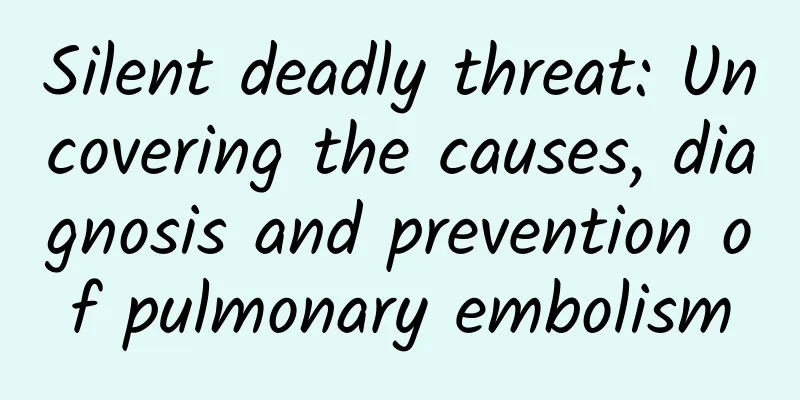Silent deadly threat: Uncovering the causes, diagnosis and prevention of pulmonary embolism

|
Author: Yang Kangli, The First Affiliated Hospital of Zhengzhou University Reviewer: Wang Hongmin, Chief Physician, The First Affiliated Hospital of Zhengzhou University Pulmonary embolism has the characteristics of sudden onset, high misdiagnosis rate, rapid changes in the condition and limited treatment methods. It is a disease that doctors are terrified of and are doubly vigilant about. Life and death often happen in a split second. In the autopsy results of patients with unexplained sudden death, pulmonary embolism is a major cause. Just like the silt that causes river blockage, the emboli that cause pulmonary artery blockage can be blood clots, tumor embolism, air embolism, fat embolism, and amniotic fluid embolism, among which blood clots are the most common. 1. How does pulmonary embolism form? If blood stasis in the veins of the lower extremities forms deep vein thrombosis, the thrombus embolus will enter the pulmonary artery with the blood circulation, which may cause pulmonary embolism. In a train or airplane with limited space, sitting for a long time while playing mahjong or games, and staying in bed for a long time are all common risk factors that can easily cause pulmonary embolism in daily life. Most blood clots are small, or can be self-dissolved by the body's fibrinolytic system; but if the patient suffers from autoimmune diseases, or is in a state of malignant tumors, acute inflammation, heart failure, or respiratory failure, the hypercoagulable state of the blood will be aggravated by the action of multiple factors, and the thrombus will travel in the blood vessels and eventually be intercepted in the vascular network of the arteries and veins in the lungs. Depending on the size of the thrombus, it will stay in the lumen of blood vessels of different diameters, causing blockage. Figure 1 Copyright image, no permission to reprint 2. How to identify pulmonary embolism early? Unlike cerebral infarction and myocardial infarction, pulmonary embolism is a thrombus in the venous system, so the symptoms are more hidden, and most patients may not have any clinical manifestations. The so-called "chest tightness, chest pain, and hemoptysis" triad refers to the clinical symptoms of pulmonary infarction caused by large-scale vascular obstruction. It is a special type of pulmonary embolism, and the diagnosis of this condition is relatively easier. The most common symptoms of acute pulmonary embolism are dyspnea, shortness of breath, chest tightness, chest pain, cough, and occasional hemoptysis. Large-area pulmonary embolism may cause hypotension, tachycardia, syncope, and even cardiac arrest, which is life-threatening. It should be noted that before pulmonary infarction occurs, dyspnea may be the only symptom, which is not obvious at rest but may worsen during activity. Figure 2 Copyright image, no permission to reprint Other patients have no obvious clinical symptoms or only show fatigue, decreased activity tolerance, etc. A small number of patients with acute pulmonary embolism may also have symptoms of deep vein thrombosis, such as pain, swelling, and/or redness and swelling of the lower limbs or arms. But whether it is pulmonary embolism or pulmonary infarction, the diagnosis is based on CT imaging of the pulmonary artery, assisted by coagulation tests, blood gas analysis, myocardial enzymes, electrocardiogram, cardiac color ultrasound, etc., and screening for pulmonary embolism risk factors is also carried out. 4. What should I do if I encounter pulmonary embolism? The main treatments for pulmonary embolism include anticoagulant therapy and thrombolytic therapy. A small number of patients are not suitable for anticoagulant or thrombolytic therapy. If circumstances permit, interventional or surgical treatment should be considered. Each disease has different severity. If pulmonary embolism has been confirmed, there is no need to be overly nervous. It is the wisest choice to cooperate with the doctor. The most basic measure is to maintain a calm state of mind, avoid strenuous activities, and prevent dry stools. General treatment measures that may be required include oxygen inhalation, blood pressure monitoring, and electrocardiogram examinations. The main treatment methods include anticoagulant therapy and thrombolytic therapy. Some patients also need to consider interventional or surgical treatment. The most commonly used traditional oral anticoagulant is warfarin. Remember to monitor the coagulation function according to the doctor's instructions during medication. 5. How to prevent pulmonary embolism? For patients who have been immobilized for a long time or have the risk of hypercoagulation, it is necessary to use anticoagulants under the guidance of a doctor or take physical measures such as wearing elastic stockings, arteriovenous pulse pressure and air pressure. When the symptoms worsen or there is no obvious relief, attention should be paid to check whether there is pulmonary embolism. "Sedentary people" in life or work must pay attention to more activities, drink more water, and try to avoid standing or sitting for a long time and crossing their legs. The essence of combining work and rest is to combine movement and stillness, and get the muscles and blood moving! Such a high-risk disease can be solved simply by a healthy lifestyle, so what are you waiting for? |
<<: Let me show you a different kind of "toothache" - trigeminal neuralgia
>>: Let's learn about familial Mediterranean fever
Recommend
What are the disadvantages of eyebrow tattooing?
Eyebrow tattooing is a common practice in our liv...
Teaching steps for correct breastfeeding posture
Both mother and baby must be in a comfortable pos...
What causes breast pain 10 days before menstruation?
There are many reasons for breast pain. For some ...
Why does semen sting during sex without inflammation?
Sex is the most important activity in life. For t...
What are the benefits of eating stinky tofu? How to make the sauce for fried stinky tofu
Fried stinky tofu is a very famous snack that man...
How to have sex as soon as possible after abortion
Abortion is a method of artificial abortion. This...
Is non-invasive testing accurate at 13 weeks?
Every pregnant woman should have accurate control...
What to eat during menstrual period
During the menstrual period, women's immunity...
What to eat to quickly abort the baby
For some women under the age of 18 who do not wan...
What should you pay attention to when you have menstruation during breastfeeding?
Nowadays, many women report that they have menstr...
How to read the normal fetal heart rate monitoring chart
According to statistics, nearly two-thirds of int...
Will physical constitution affect women's morning sickness during pregnancy?
Morning sickness is a very normal reaction to pre...
Morning sickness is severe at night, it's a boy
During pregnancy, pregnant women will experience ...
The dangers and side effects of female intrauterine device
Female IUD is a commonly used contraceptive metho...



![[Solar terms health care] Here is a guide to the grain in ear health care for you, follow it to avoid getting sick in summer](/upload/images/67f1f32f01c59.webp)





